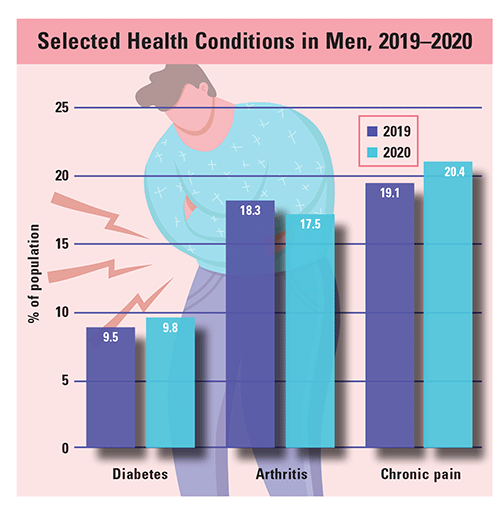US Pharm. 2022;47(6):14.
The National Health Interview Survey, which was conducted by the National Center for Health Statistics, examined men’s health status for a variety of diseases. In terms of common diseases, the proportion of men who experienced chronic pain in 2020 was 6.8% higher than in 2019 (20.4% vs. 19.1%). For newly diagnosed diabetes, 3.2% fewer cases were reported in men in 2019 than in 2020 (9.5% vs. 9.8%). Interestingly, there was a 4.4% decline in arthritis diagnoses from 2019 to 2020 (18.3% vs. 17.5%).

Functional Difficulties: In men, the ability to perform normal functions decreased from 2019 to 2020. The proportional decline was 15.4% for self-care (from 3.9% to 3.3%), 5.4% for hearing (from 16.7% to 15.8%), and 1.9% for walking or climbing steps (from 15.5% to 15.2%). The proportion of men with difficulty remembering or concentrating increased by 6% (from 14.9% to 15.8%), difficulty communicating increased by 3.8% (from 5.2% to 5.4%), and difficulty seeing increased by 0.7% (from 14.6% to 14.7%). Regarding men aged 65 years and older, 47.4% had some difficulty performing normal functions and 20.1% had a lot of difficulty performing them. With age progression (i.e., from age group 18 to 64 years to age group 65 years and older), the proportion of men who were completely unable to function increased threefold (from 6.7% to 20.1%).
Circulatory and Respiratory Diseases: Compared with 2019, 4.3% more men had high cholesterol levels in 2020. The proportion of men who had heart attacks, coronary heart disease, and diagnosed hypertension remained stable (at 4%, 5.9%, and 27%, respectively) from 2019 to 2020. However, there were 5.9% fewer cases of angina in 2020 than in 2019 (1.6% vs. 1.7%). The prevalence of asthma episode or attack remained constant (at 2.3%) in 2019 and 2020. However, the same period saw a 1.6% increase in current cases of asthma (from 6.1% to 6.2%) and a 4.9% increase in cases of chronic obstructive pulmonary disease, emphysema, or chronic bronchitis (from 4.1% to 4.3%).
Mortality Rates for Selected Diseases: Among the primary causes of death in men, chronic lower respiratory diseases had a mortality rate of 43.7/100,000 population; tracheal, bronchial, and lung cancers had a rate of 41.8/100,000; and cerebrovascular diseases had a rate of 37.6/100,000. Rates for diabetes and Alzheimer’s disease were 26.9/100,000 and 24.5/100,000, respectively. For colorectal and anal cancers, the rate was 15.9/100,000, and that for nephritis, nephrotic syndrome, and nephrosis was 15.8/100,000. Mortality rates for influenza and pneumonia and for prostate cancer were 17.3/100,000 and 18.8/100,000, respectively.
The content contained in this article is for informational purposes only. The content is not intended to be a substitute for professional advice. Reliance on any information provided in this article is solely at your own risk.
To comment on this article, contact rdavidson@uspharmacist.com.






